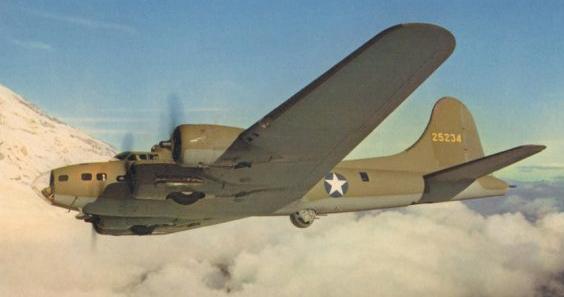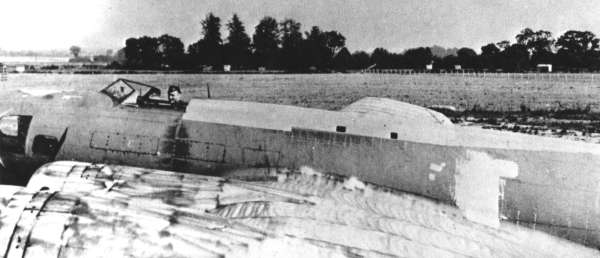Boeing BQ-7 Aphrodite
In July 1944, the USAAF implemented the idea to convert "war-weary" B-17 Flying Fortress bombers to radio-controlled assault drones. About 25 B-17s, mostly B-17F, were converted to BQ-7 configuration under program Aphrodite. The BQ-7 was to be flown from Great Britain against very hardened and/or heavily defended German targets, like e.g. submarine pens or V-1 missile sites.
 |
| Photo: Nels Christensen, via 303rd Bomb Group Association |
| B-17F |
The BQ-7 was filled with about 9000 kg (20000 lb) of Torpex high-explosive and fitted with an impact fuze. During take-off and initial climb, the BQ-7 was manned by a crew of two, a pilot and an engineer. After reaching cruise altitude, the crew pointed the aircraft toward the general direction of the target, activated the remote-control equipment, armed the fuze, and parachuted to the ground. To facilitate bail-out, the B-17's canopy was removed, and the cockpit converted to an open one with a windshield only. The BQ-7 was then controlled from another B-17, modified to CQ-4 configuration, which accompanied the BQ-7 on its way to the target. The formation was completed by a fighter to shoot the BQ-7 down in case of a loss of control. Once the drone was close enough to the target, its controls were locked for a terminal decent, and the control plane turned away. After the first missions, some BQ-7s were fitted with two TV cameras, one in the cockpit to watch the instrument panel, and one obliquely in the nose to watch the flight path over the ground. The TV images were transmitted to the CQ-4, so that visual tracking of the BQ-7 was not necessary, giving the weapon a stand-off capability.
 |
| Photo: USAF |
| BQ-7 |
The first of 15 Aphrodite missions occured on 4 August 1944 against a V-1 site, and operations continued with low priority until January 1945. However, not a single BQ-7 attack was considered a definite success. The drones suffered all kinds of failures, mainly related to the autopilot and remote-control equipment. Several BQ-7s went out of control, and a few actually crashed and exploded on British soil, luckily without inflicting major damage. Other problems included poor visibility via the TV image (leading to aiming errors of several 100 meters at best and several miles at worst), and the vulnerability of the non-manoeuvering BQ-7 to anti-aircraft fire.
Although sounding promising in theory, the BQ-7 Aphrodite concept was clearly a failure, mainly because the equipment of the time was not yet up to the task. A very similar effort to convert worn-out B-24 Liberator bombers to BQ-8 assault drones was even less successful. Post-war, the designation MB-17G was reserved for possible conversions of surplus B-17Gs to missiles in the style of the BQ-7, but it seems that no MB-17Gs were actually built.
Specifications
Note: Data given by several sources show slight variations. Figures given below may therefore be inaccurate!
Data for BQ-7:
| Length | 22.78 m (74 ft 9 in) |
| Wingspan | 31.64 m (103 ft 9.5 in) |
| Height | 5.82 m (19 ft 1 in) |
| Weight | 28600 kg (63000 lb) |
| Speed | > 320 km/h (200 mph) |
| Ceiling | 11400 m (37500 ft) |
| Range | 560 km (350 miles) |
| Propulsion | 4x Wright R-1820-97 piston engine; 890 kW (1200 hp) each |
| Warhead | 9000 kg (20000 lb) high-explosive |
Main Sources
[1] Bill Gunston: "The Illustrated Encyclopedia of Rockets and Missiles", Salamander Books Ltd, 1979
[2] Kenneth P.Werrell: "The Evolution of the Cruise Missile", Air University Press, 1985
[3] Peter M. Bowers: "Boeing Aircraft since 1916", Putnam, 1989
Back to Directory of U.S. Military Rockets and Missiles, Appendix 1
Last Updated: 26 March 2003